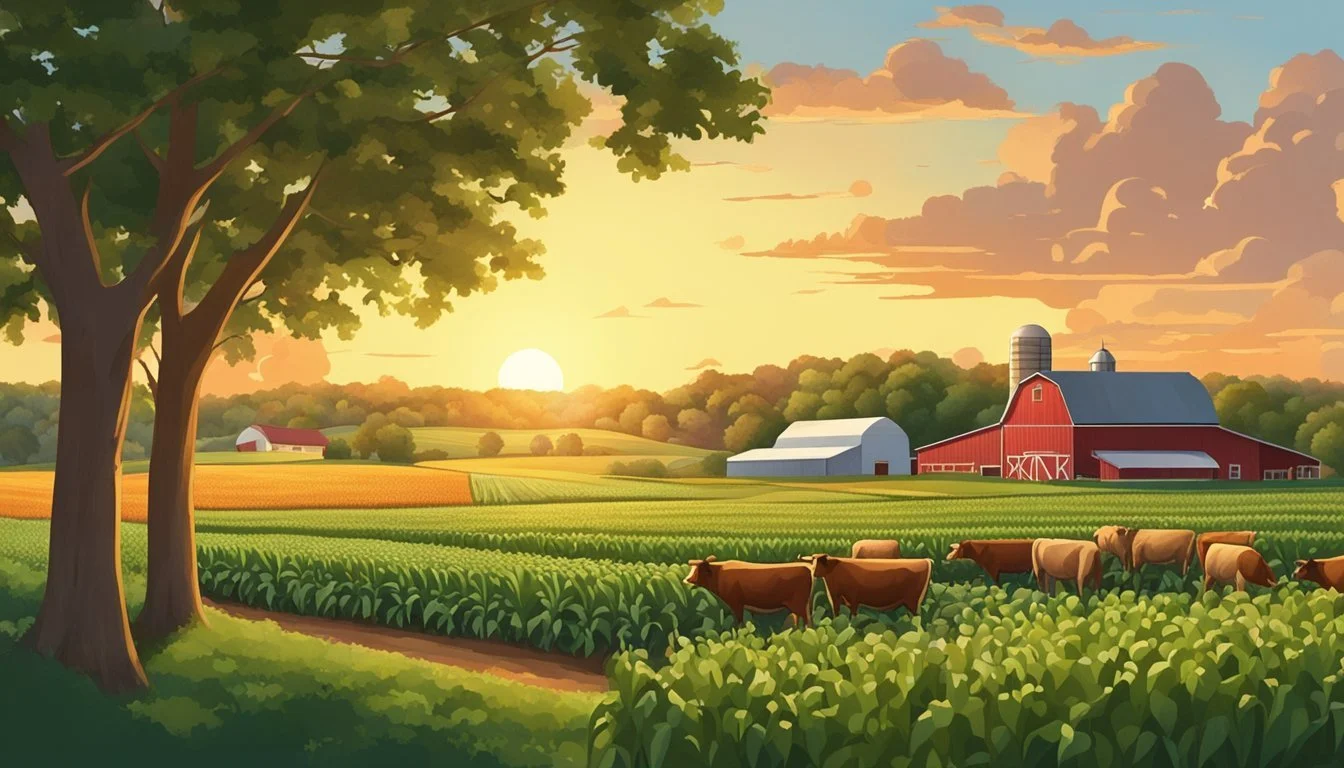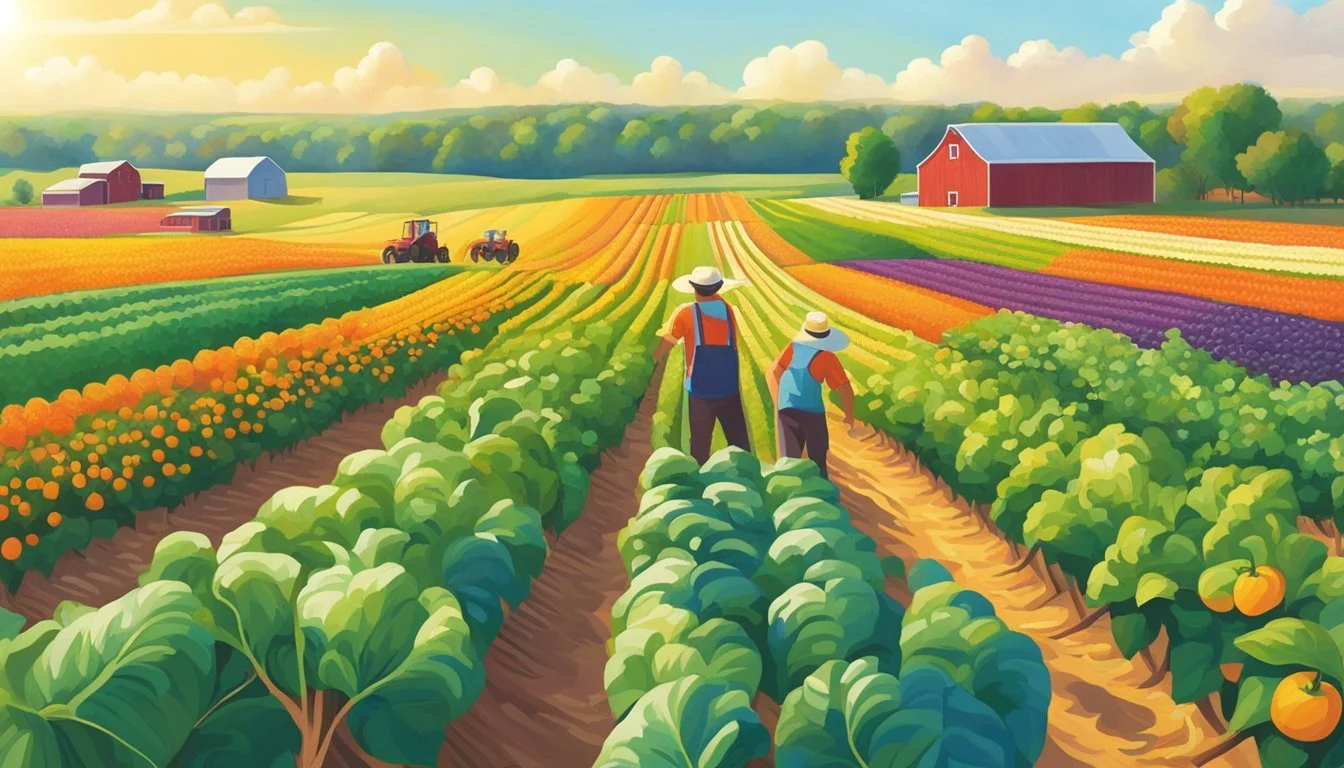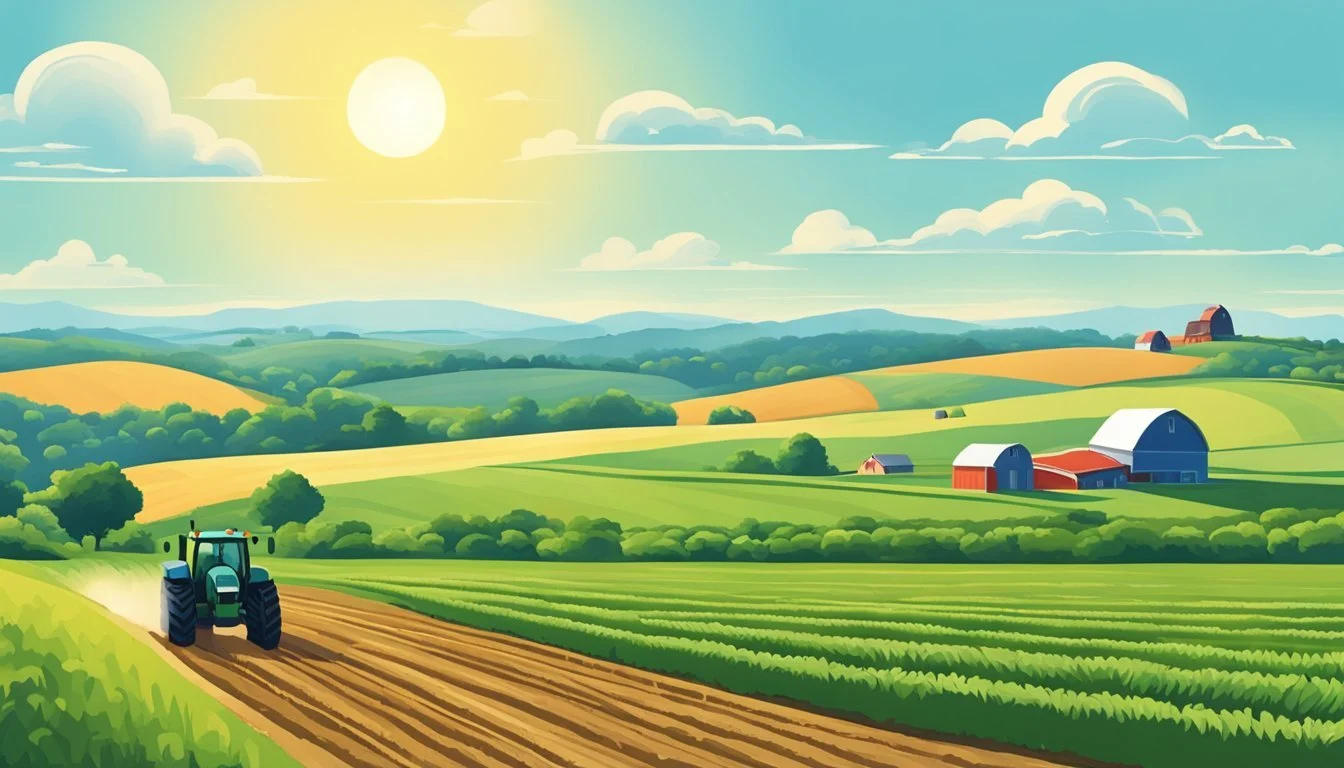Guide to Farming in Illinois
Essential Tips for Successful Agriculture
This Article is Part of Our State by State Farming Guide
Illinois stands at the forefront of the United States' agricultural industry, showcasing its vitality through a rich tradition of farming. Characterized by its fertile plains and favorable climate, this Midwestern state has secured its reputation for being one of the top contributors in the nation's crop production. Agriculture forms the backbone of Illinois’ economy, with the state specializing in grains and oilseeds. Corn (how long does corn last?) and soybeans, (how long do soybeans last?) in particular, dominate its vast agricultural landscape, jointly covering more than 90% of its cultivated acres in recent decades.
Corn, the state's leading crop, not only feeds the nation but also fuels it, as Illinois is the largest producer of ethanol in the United States. With around 274 million bushels of corn allocated to ethanol production annually, the state's contribution to sustainable energy sources is noteworthy. Additionally, Illinois farmers balance modern agricultural practices with initiatives that focus on sustainable and organic farming, demonstrating a dynamic approach that caters to diverse market demands.
Support for this dynamic industry is robust, with resources like the Illinois Farm Bureau and the University of Illinois Extension providing invaluable research, education, and support services. Beginning farmers and ranchers find guidance and assistance available through various programs, equipping them to navigate the complexities of the modern agricultural world. This infrastructure of support not only sustains existing farm operations but also fosters the growth of new ventures, ensuring that Illinois' farming heritage continues to thrive.
The Importance of Agriculture in Illinois
Agriculture is a cornerstone of Illinois’ economy, significantly contributing to job creation and playing a crucial role in both national and global markets.
Economic Impact and Job Creation
Agriculture is a key driver of Illinois' economy, representing a substantial component of its gross domestic product (GDP). The sector not only contributes about $51.1 billion in value-added services but also sustains numerous jobs across the state. Farmland covers a major portion of Illinois’ landscape, with 76% allocated to cropland. This extensive use of land for agricultural purposes underpins the livelihoods of many Illinois residents, from farmers directly tending to the fields to those involved in the broader Illinois supply chain.
Role in the National and Global Markets
Illinois has earned a distinguished place on the national stage, ranking as the #1 soybean producing state and the #2 corn producing state in the United States. The state is responsible for 15% of the country's soybeans and 13% of its corn. These figures are not just national statistics but also underscore Illinois' pivotal role in global markets. Illinois exports these commodities worldwide, facilitating trade and strengthening global food systems. The effective use of the state’s geography and climate has positioned Illinois farmers to be key contributors to both the nation’s agricultural output and to meeting global demands.
Understanding Illinois Climate and Soil
Illinois boasts fertile soils and a climate that traditionally favor agricultural productivity. This underpins the state's status as a major agricultural powerhouse, with a significant area devoted to farming.
Optimal Growing Conditions
Illinois' agricultural success stems from its rich, black soil, which is a product of glacial deposits, and its typically favorable climate. The state experiences a range of temperatures that provide a comfortable environment for a variety of crops. Illinois typically has warm summers with temperatures that facilitate plant growth, while the winters allow for a resting period for the soil.
Soil: Rich glacial soils, primarily prairie-derived mollisols, offer ideal conditions for root growth and water retention.
Climate: Defined by four distinct seasons with sufficient rainfall distributed throughout the growing season.
Rivers: Water access from rivers like the Mississippi, Illinois, and Ohio is beneficial for irrigation and transportation.
Challenges and Solutions
Yet, the climate in Illinois is not without its challenges. Increased frequency of extreme weather events, such as excess water and drought conditions, can impede farming operations.
Temperature and Air: Extreme temperatures and changes in air patterns affect planting and harvest times.
Water: Intense rainfall can lead to soil erosion and nutrient runoff, while droughts can severely limit water availability.
Solutions to these challenges include adopting climate-smart and regenerative farming practices to counteract soil erosion and improve water management. Additionally, farmers are increasingly informed about financial incentives for implementing practices that reduce greenhouse gas emissions, such as:
Traditional financial assistance programs
Market-based approaches
This adaptability ensures that despite environmental challenges, agriculture in Illinois can continue to thrive.
Key Crops and Livestock in Illinois Farming
Illinois excels in agricultural production, with grain crops like corn and soybeans as the cornerstone of its farming industry, augmented by diverse livestock farming including pork production.
Corn and Soybean Dominance
Illinois is renowned for its extensive grain production, particularly of corn and soybeans. It stands as the second largest corn producer in the United States, contributing 13% of the nation's corn supply. This dominance is reflective of the state's rich soil and favorable growing conditions, making it a pivotal player in grain markets.
Soybeans reinforce Illinois' agricultural stature, being the top soybean producing state. Illinois farms are responsible for 15% of the U.S. production of soybeans, emphasizing the vast scale and efficiency of its soybean cultivation practices.
Diversity of Livestock
The livestock sector in Illinois is equally robust, with a particular focus on pork production. Within this sector, farms range widely in size and output, demonstrating the state's versatility in livestock management. Illinois' livestock farms contribute significantly to the agricultural economy, not just by means of pork, but through a myriad of other products integral to the industry.
Aside from pork, Illinois farmers also raise a variety of other livestock but they are best known for their substantial hog inventory, ranking fourth in the nation. Their comprehensive livestock care practices reflect a commitment to both quality and volume, showcasing advanced farming techniques that sustain and empower the state's agriculture.
Sustainable Farming and Environment Protection
Sustainable farming in Illinois aims to balance economic viability with environmental stewardship. It encompasses a range of practices focused on protecting natural resources, utilizing clean energy, and ensuring the longevity and health of agricultural systems.
Innovations in Sustainable Practices
Soil Conservation: Farmers in Illinois adopt conservation tillage methods such as reduced till or minimum tillage to reduce soil erosion. This practice minimizes the turning over of soil, thereby preserving its structure and nutrients.
Pest Control: Eco-friendly pest management strategies are implemented to control pests without harming the environment, farmers, or consumers.
Water Resources: Sustainable agriculture in Illinois also includes protecting water quality by managing runoffs, thus ensuring cleaner water for all.
Renewable Fuels and Energy
Biomass and Renewable Fuel Production: The state supports the production of renewable fuels, including bioenergy from agricultural waste, which helps in reducing the carbon footprint of farming activities.
Solar and Wind Energy: Adoption of solar panels and wind turbines on farms allows for harnessing clean energy, thus reducing reliance on non-renewable energy sources and promoting sustainable farming practice.
By integrating these forward-thinking sustainable practices and renewable energy sources, Illinois farmers are contributing to the protection of natural resources and advancing towards a more resilient and eco-friendly agricultural future.
Illinois Specialty Crops and Markets
Illinois' fertile lands and favorable climate contribute to its status as a leading producer of a variety of specialty crops. Farmers' markets across the state play a pivotal role in connecting consumers with these local and organic products.
Market for Organic and Specialty Products
Illinois excels in the production of specialty crops, which include fruits and vegetables, tree nuts, dried fruits, and horticulture and nursery crops. The definition encapsulates a broad range of produce, with Illinois notably ranking No. 1 in pumpkin and horseradish production within the United States. Additionally, it is among the top 10 producers for crops like asparagus, cauliflower, broccoli, peas, and snap peas.
Pumpkins: Top producer in the U.S.
Asparagus: Ranked in the top 10
Cauliflower: Ranked in the top 10
Farmers Markets: Third-highest number in the nation.
The market for these products includes not only fresh consumption but also value-added products such as canned goods, sauces, and organic snacks.
From Farm to Local Markets
Illinois supports a robust network of farmers’ markets, which is the third-largest in the country. These markets facilitate the bridge from farm to table, showcasing the state’s commitment to local food movements and providing farmers with direct access to consumers.
Local Food Movement: Strengthens farm-to-table connections.
Farmers Markets: Over 300 operating across the state, connecting local farmers with communities.
At these markets, consumers can find a wide array of Illinois specialty crops, ensuring that fresh, locally-sourced produce is readily available. This direct marketing approach has benefits for both producers and consumers, fostering a stronger local economy and increasing the accessibility of healthy, organic options.
Education and Extension Services
In Illinois, education and comprehensive extension services play a crucial role in bolstering the state's agricultural prowess. The integration of academic knowledge and practical training ensures that farming communities have access to the latest research and developments.
Role of Agricultural Education
Illinois places a strong emphasis on agricultural education with a series of established programs designed to inform and teach both current and future generations of farmers. The University of Illinois Extension serves as a key institution, offering education that spans from the basics to advanced agricultural practices. This education is critical to maintaining the state’s leadership in commodities like soybeans and corn.
Contributions of Extension Services
Illinois Extension Services, functioning under the University of Illinois Extension, substantially contribute to the farming community. With a workforce that includes 37 agriculture educators and specialists, the Extension Services provide training and continuing education for Master Gardener and Master Naturalist volunteers. These efforts not only aid in improving agricultural yields but also in ensuring environmental conservation. Furthermore, the Illinois Extension is actively involved in community outreach, delivering programs in nutrition, wellness, and sustainability, among others.
Key Offerings of Illinois Extension Services:
Research-based agricultural programs
Training and education for volunteers
Community outreach initiatives
They ensure that the state's farming practices evolve with time, incorporating cutting-edge techniques and knowledge to maintain Illinois’ position as a top exporter in agricultural commodities.
Technological Advances in Agriculture
Agriculture in Illinois has embraced the fusion of technology and tradition to optimize farming practices. Technological innovations are not only shaping sustainable farming but are also enhancing efficiency in disease and pest management.
Modernizing Farm Operations
Drones: They have become an integral tool for Illinois farmers, providing aerial views that assess crop health and monitor growth patterns. These eye-in-the-sky technologies enable farmers to make informed decisions without the need for physical field checks.
Precision Agriculture Tools: Fertilizer application is undergoing a transformation in Illinois, with tools that guarantee precise application rates. This ensures that nutrients are delivered effectively to crops, improving yield while minimizing waste and environmental impact.
Technology for Disease and Pest Management
Disease Detection Systems: Timely detection of plant diseases is crucial. Farmers are now employing advanced sensors and diagnostic tools to identify and act upon disease threats quickly, mitigating potential damage to their crops.
Pest Control Technologies: Insects can severely compromise crop health. Illinois farmers have access to innovative pest control methods, incorporating targeted treatments that protect crops from insects while reducing the need for broad-spectrum pesticides.
Financial Aspects of Farming
The financial health of a farm dictates its ability to operate and grow. Budgeting and cost management are essential for profitability, while effective marketing ensures products reach the market efficiently and profitably.
Budgeting and Managing Farm Costs
Farmers must meticulously plan their budgets due to the fluctuating costs associated with agricultural field operations and inputs. Estimated costs for growing major crops like corn and soybeans can be significant, covering seed, fertilizer, chemicals, and machinery expenses. To exemplify, the total economic cost per acre for corn in Illinois in 2022 might comprise:
Seed: $125
Fertilizer: $200
Chemicals: $35
Machinery: $75
These costs underscore the importance of comprehensive financial planning. They must also allocate funds for land payments, whether as mortgage or rent, insurance, and labor. Given the variability in input costs, especially as noted in changing conditions between 2021 and 2022, staying current on market trends and hedging against risk are critical strategies.
Marketing Strategies for Farmers
Marketing is a vital aspect of the agriculture industry, determining the extent to which a farmer can capitalize on their efforts. Farmers are encouraged to engage with multiple marketing channels to avoid reliance on a single revenue stream. Strategies may include direct-to-consumer sales, farmers' markets, or contracts with grocery chains and food processors. The choice of marketing channels often depends on the type of product being sold, with different channels suited to commodity crops than to specialty products or value-added goods.
In Illinois, grain marketing strategies may vary, but they often involve a mix of futures contracts, spot market sales, and crop insurance programs to protect against price volatility. Given the record net farm income in 2021, farmers need to understand market demand and supply dynamics to maintain or improve profitability in the face of projected lower incomes for 2024. Engaging with market analyses, as provided by platforms like farmdoc, can equip farmers with necessary insights into market trends and pricing forecasts.
Agriculture Industry Partners and Resources
In Illinois, the agriculture industry is substantially supported by cohesive partnerships and resources. These alliances enhance farming practices and bolster the state’s robust food and agricultural sector.
Support from Governmental Departments
The Illinois Department of Agriculture plays a pivotal role in supporting farmers. It offers a suite of services encompassing:
Regulatory guidance
Marketing assistance
Education and advocacy
Conservation programs
They collaborate with local farmers to ensure sustainable practices and facilitate access to both local and international markets.
Collaboration with Food Manufacturing
The synergy between Illinois farms and food manufacturing companies is integral to the state’s economy. Illinois is known for its vast production of corn and soybeans, which are essential inputs for a variety of processed foods:
Key Crop Uses in Food Manufacturing Corn Sweeteners, Ethanol, Animal Feed Soybeans Oil, Animal Feed, Biodiesel
Processed food sales from Illinois benefit directly from the high-quality crops grown within the state, reflecting the interconnected nature of agriculture and manufacturing sectors. With a focus on maintaining a loop of supply and demand, both farmers and manufacturers work together to sustain a vibrant agribusiness climate.
Family Farms and Community Impact
In Illinois, family farms constitute the backbone of rural communities, shaping both the cultural heritage and the economic stability. They foster a sense of unity and shared purpose that transcends generations.
Traditions and Heritage of Family Farms
Illinois' family farms are repositories of a rich agricultural heritage that has been passed down through generations. It's not just about growing crops and raising livestock; it's a living tradition that encompasses the values of hard work, stewardship, and continuity. These family enterprises embody the historical growth of the state and maintain the traditions that define the rural character of Illinois.
Farming as a Community Pillar
Family farms serve as central pillars in their communities, significantly contributing beyond economic benefits. They cultivate our communities by:
Uplifting Local Economy: Family farms fuel local businesses and create employment, strengthening the economy.
Educational Opportunities: They provide avenues for agricultural education and awareness, fostering community knowledge.
Social Fabric: Family farms organize and participate in community events, forging stronger community ties.
Community Health: By producing fresh, local food, these farms contribute to the health and wellness of community members.
Illinois family farms are integral to the state, demonstrated by initiatives like "Cultivating Our Communities", which showcase the contributions of these agricultural businesses in connecting rural, suburban, and urban areas.
Conclusion
Illinois has proven itself to be a vital contributor to the agriculture sector in the United States, particularly in the production of corn, where it holds the position of the second-largest producer. State farms supply 13% of the nation's corn, and agricultural land constitutes 76% of Illinois's total land area. These statistics reflect the state's importance in food security and economic stability.
The focus on sustainability is evident with the state's legislative steps towards expanding sustainable and regenerative practices. Ethanol production is another significant aspect of Illinois's farming economy, providing substantial employment and supporting the energy sector.
Farmers markets in Illinois are thriving, with the state ranking third in the nation. These markets are critical for providing residents with fresh, healthy produce and for fostering a connection between consumers and growers. This direct marketing channel supports both the state's economy and the health of its citizens.
Family farms form the backbone of Illinois's agricultural industry. They are an integral part of its economic fabric, with far-reaching impacts beyond the provision of food, fuel, and fiber. Through innovation and community involvement, Illinois farmers continue to pave the way for a more food-secure and thriving economic future.













